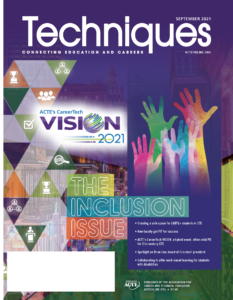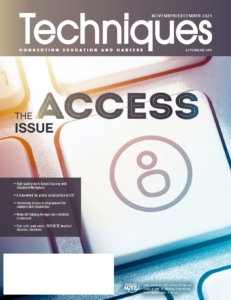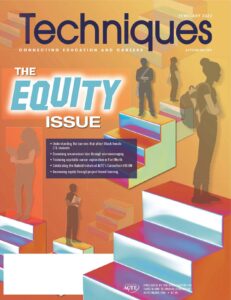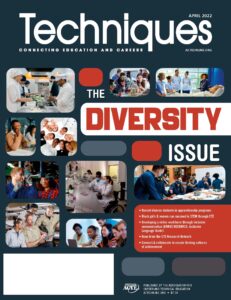Read Techniques: Year in Review, 2021–22
As Techniques looks forward to the school year with its VISION goes to Vegas issue coming soon, we’re also reflecting. Our 2021–22 Year in Review features some of the most innovative and insightful content we’ve published in print and online since the fall of 2021. “Career and technical educators work with dedication to prepare the workforce,” wrote Lia Milgram, managing editor, last September. “And our classrooms are filled with diverse young people ready to take on the world’s challenges.”
Read Techniques: Year in Review, 2021–22

Leading the way for ambitious women in CTE
In the summer of 2021, career and technical education (CTE) professionals screened Pioneers in Skirts, an award-winning impact film, as part of ACTE’s inclusion, access, equity and diversity (IAED) webinar series. Educators enjoyed an opportunity to meet the filmmakers and discuss the systemic barriers women face in pursuit of high-wage, high-demand career pathways.
“After four years of following pioneering women and gathering the fact, I am excited for the impact this film will have,” said Ashley Maria. “Not just for women or the film industry, but for cultures wanting to play a role in changing the outcome for women today and the next generation. READ MORE.
Inspiring all students to innovate with #CareerTechEd
When students can think, design, build and create, the only limitation is their imagination. As innovators, we get to create things that never existed before. Peter Wachtel, an architecture and product innovation design teacher in California, helps his students see that everything around them is worthy of exploration. He tells them, take that desire and love for what you do and make it part of your life.
Product Innovation & Design & Architecture pathways combine:
- Arts, media & entertainment
- Architecture & engineering
- Manufacturing & product development
- Building trades & construction
Students learn basic to advanced skills, and they gain real-world experience designing for industry. The program also supports articulation agreements with community and state colleges; more than 150 students have received articulated credit to date. And, thanks to industry partners across the state, students benefit from field trips, guest lectures, internships and employment. These experiences generate critical thinking and other vital employability skills. READ TECHNIQUES.
Greater access to career pathways via registered apprenticeship

Research by Gallup and Carnegie Corporation shows that some 46% of adults want their children to pursue alternative pathways into the workforce. In the business world, three in four human resources professionals support eliminating the four-year degree barrier for job candidates. But misconceptions remain — specifically regarding how alternative pathways function and how learners benefit.
Apprenticeship — the “earn while you learn” model — delivers significant value in the hands-on trades like construction and manufacturing. Further, it holds much promise in current and emerging tech fields like health care, robotics, green infrastructure and artificial intelligence. This helps employers to fill their most pressing needs with workers who possess relevant skills. And it also represents an exciting opportunity for those from historically underserved communities and for those who have been barred, by circumstance or by hiring bias, from the workforce. READ MORE
A framework for global social justice in CTE
Social justice has become a focus for educators and educational systems around the world. The Center for Global Education at Asia Society has partnered with ACTE to address equity issues for all students in career development and preparation. We developed a framework to assist educators in reflecting on their students and educational environments.
Take a moment to consider:
- What cultural experiences do your students bring to your program?
- How well do your students overcome obstacles and find support when they need it?
- What employment experiences do your students bring?
- What opportunities have students already had in your specific career field?
Global social justice education challenges all educators to utilize global competence as a framework to recognize systems of injustice, and to work to create equitable learning environments for all participants. The Global Social Justice Education Framework provides a model to help ensure that CTE programs are designed to prepare all students for success in our interconnected world. READ TECHNIQUES.

A brief guide to data analysis
Data analysis can be exciting and sometimes overwhelming. Approaching the project with a strategy can make the process go smoother. Mandinach and Gummer interpreted data literacy as “the collection, examination analysis, and interpretation of data to inform some sort of decision in an educational setting;” this is relevant because the data analysis process increases one’s data literacy skills. The stages in the data analysis process include:
- Identifying the objective
- Preparing and cleaning the data
- Analyzing and interpreting the data
- Sharing the data and results
Start the process by identifying the objective for your data analysis. Select an objective that is aligned with instructional improvement, such as a question that needs an answer or a situation that requires more information. Next, determine why the data needs to be analyzed. The goal could be to clarify if inequities exist; to track data that align with district initiatives; to track data that are reported to the state so that early warning systems can be set up; or to compare a school or district to another school, district, or statewide. READ MORE.
Equitable career exploration in Fort Worth, Texas
Reaching every student to plan for life after high school in a large, urban school district can be a formidable assignment. But the educators at Fort Worth Independent School District (FWISD) go above and beyond to connect with as many students as possible. Their experiences have helped identify tools and strategies to, effectively and equitably, connect the district’s diverse population to high-wage, high-demand career pathways.
Wherever students’ interests extend — from automotive to aviation or cybersecurity to culinary — they often know some of their own inclinations by middle school. FWISD’s college and career readiness coaches then begin working with students in sixth grade. Students learn college terminology, explore careers, consider what colleges they may like to visit and much more. With seventh graders, the coaches concentrate on exploring career pathways of interest and discussing their high school options. Ultimately, the goal is for students to feel like they are equitable partners in their education. READ TECHNIQUES.

Racing into STEM careers
“Everything you do here, you get points,” said Anthony Martin, founder and director of the Urban Youth Racing School (UYRS) in Philadelphia, Pennsylvania. “Students get points for showing up for class. They get points for their work, points for behavior, all that stuff,” Martin explained. “The most points they can get, though, are for their school grades.”
The Urban Youth Racing School has been a passion for Martin and his wife, Michelle, for the past 23 years. Their goal is to expose youth to the exciting sport of auto racing. And the hope is that their experience with UYRS leads to STEM careers.
The first five weeks involve classroom experiences around the design, construction and testing of CO2 dragsters — including data analysis from Pitsco Education wind tunnels that measure forces of drag and lift on the students’ dragsters and other model cars they create. Based on wind tunnel data, students modify the design and features of their cars to improve performance. Over the second five weeks, student teams go head-to-head on the go-kart track to apply what they learned in the classroom. READ MORE.
Developing a richer workforce through inclusive communication
High-quality CTE programs can propel all students toward career success. This happens when educators prioritize the development of academic and employability skills, such as communication, reading comprehension, and emotional intelligence. Educators must also ensure their programs are relevant, both to engage students and to fulfill workforce demands. To meet these goals, we must consider how the language we use conveys meaning. How we talk to students and how we talk about students matters.
ACTE staff developed an inclusive language resource to guide our own work. And we hope it may guide yours as well. Because when we choose language that celebrates our differences, we can build a richer, stronger workforce in CTE. READ TECHNIQUES
Lia Milgram is managing editor for ACTE.


